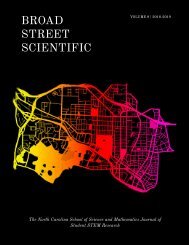Broad Street Scientific Journal 2020
You also want an ePaper? Increase the reach of your titles
YUMPU automatically turns print PDFs into web optimized ePapers that Google loves.
picked from the treatment plates to agar pads spotted with
M9 buffer. Often worms were picked incorrectly and died
very quickly. Thrashing scores of these worms were discarded
from analysis.
6. Current Work
Expression patterns of Wnt related genes during larval
development have been extensively studied using transgenic
reporter gene based assays. Wnts have been established
to act as morphogens, providing cells in developing tissue
with positional information in long-range concentration
gradients [14]. Sawa and Korswagen [14] looked at Wnt
related genes, BAR-1, POP-1, GSK-3, PRY-1, MOM-2,
MOM-5, KIN-19, which are orthologs of significant genes
that partake in Wnt/β-Catenin signaling. BAR-1 (β-catenin/armadillo-protein
1) functions as a transcriptional activator,
and along with POP-1 (ortholog of Tcf), regulates
cell fate decision during larval development [15]. GSK-3
(Glycogen synthase kinase-3) is the ortholog of human
GSK3β, a key enzyme in Wnt signaling and phosphorylation
of β-catenin [16]. PRY-1 is the ortholog of Axin-1
and is a part of the destruction complex in negatively regulating
BAR-1/β-catenin signaling [17]. MOM-2 codes a
Wnt ligand for members of the Frizzled family as well as
regulates cell fate determination [18]. MOM-5 (ortholog
of Frizzled receptor) couples to the β-catenin signaling
pathway, leading to the activation of disheveled proteins
[14]. KIN-19, ortholog of CK1 (Casein Kinase 1), has been
shown to transduce Wnt signals [19].
Future work in this study will be done to extensively
look at Wnt related gene expression within worms that
show decreased neurodegeneration. This will be done
through cDNA synthesis and real time polymerase chain
reaction. We expect to see BAR-1 expression, the ortholog
of β-catenin, and other Wnt related genes to have increased
expression within worms exposed to Wnt Agonist
1 in all concentrations. However, we expect to see less expression
of GSK-3 as decreased β-catenin is expected to be
degraded through phosphorylation.
7. Conclusions
Currently, there are no disease modifying treatments
for Parkinson’s Disease. Current PD treatments involve
the use of dopaminergic drugs to restore dopamine concentration
and motor function. These treatments do not
alter the course of PD, but they do provide improvement
in motor symptoms of patients [1]. Numbers of cell-based
treatments have responded to the need for targeted delivery
of physiologically released dopamine. One option that
recent studies have considered is the introduction of stem
cells into the striatum [1]. Lineage tracing based on Wnt
target genes has provided evidence for Wnts as significant
stem cell signals that have been detected in various organs
[16]. Wnt proteins or Wnt agonists have been used to
maintain stem cells in culture, allowing stem cells to expand
in a self-renewing state [24].
Though C. elegans do not have the same Wnt/β-catenin
signaling system as vertebrates, they are a valuable model
to test whether or not Wnt targeted therapies are effective
treatments to increase dopamine production in neurons
and decrease PD symptoms. The use of Wnt activators on
model organisms have not been well studied, especially in
the context of neurodegenerative disease.
As more studies and trials are completed on the effects
of activated Wnt/β-catenin signaling, especially through
the exposure to various agonists, we can see how organisms
respond physiologically, genetically, and behaviorally
to such changes. Further experimentation should also
consider potential side effects of such treatments as well
as the toxicity of molecules used for activation. Analysis
should further study if Wnt signaling is able to rescue neurodegeneration
by inducing DA neuron development or
through neurorepair. The most effective clinical treatment
of Parkinson’s disease can be achieved by expanding the
field and examining potential therapies.
8. Acknowledgements
I would like to thank my mentor, Dr. Kim Monahan,
and my Research in Biology class for guiding and supporting
me through the research process. I would also like to
thank Angelina Katsanis and Emile Charles for being my
lab assistants over the summer. Further thanks to Dr. Amy
Sheck, the Glaxo Endowment, and the North Carolina
School of Science and Mathematics for allowing me the
opportunity to experience research.
9. References
[1] Stoker, T. B., & Greenland, J. C. (2018). Parkinson’s
Disease: Pathogenesis and Clinical Aspects. Codon Publications.
[2] Surmeier, D. J., Guzmán, J. N., Sánchez-Padilla, J., &
Goldberg, J. A. (2010). What causes the death of dopaminergic
neurons in Parkinson’s disease?. In Progress in
brain research (Vol. 183, pp. 59-77). Elsevier.
[3] Mamelak, M. (2018). Parkinson’s disease, the dopaminergic
neuron and gammahydroxybutyrate. Neurology
and therapy, 7(1), 5-11.
[4] L'Episcopo, F., Tirolo, C., et al. (2014). Wnt/β‐catenin
signaling is required to rescue midbrain dopaminergic progenitors
and promote neurorepair in ageing mouse model
of Parkinson's disease. Stem Cells, 32(8), 2147-2163.
[5] Chen, L. W. (2013). Roles of Wnt/β-catenin signaling
16 | 2019-2020 | Broad Street Scientific BIOLOGY




